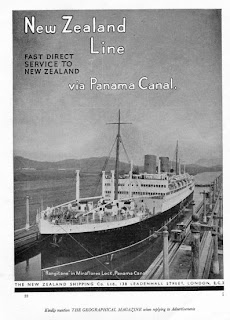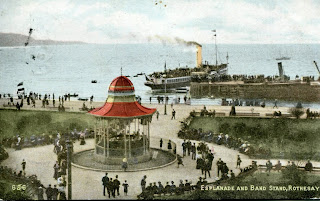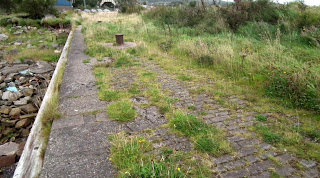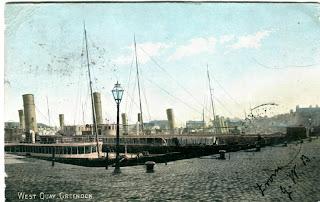Search This Blog
Friday 15 March 2013
Wednesday 20 February 2013
Tuesday 12 February 2013
Friday 8 February 2013
Sunday 13 January 2013
Saturday 5 January 2013
Sunday 11 November 2012
Craigendoran Pier
Craigendoran pier was opened to steamers on the 15 May 1882,
Wednesday 10 October 2012
Tuesday 5 June 2012
Sunday 27 May 2012
Monday 9 April 2012
Saturday 25 February 2012
West Quay Greenock
Thursday 23 February 2012
RMS Rangitane
 Magazine clipping from the early 30s,built at John Browns in 1929 and sank by German raiders in 1940 .
Magazine clipping from the early 30s,built at John Browns in 1929 and sank by German raiders in 1940 .The RMS Rangitane was a passenger liner owned by the New Zealand Shipping Company. She was one of three sister ships (the other sisters were Rangitata and Rangitiki) delivered to the company in 1929 for the All-Red Route between Britain and New Zealand. Rangitane was built by John Brown & Company and launched on 27 May 1929.[1]
The three ships each displaced 16,700 tons, 530 feet in length and nearly 70 feet in the beam. They could carry nearly 600 passengers in 1st, 2nd and 3rd classes, 200 crew members and substantial cargo. They had Brown Sulzer diesel engines with a total output of 9,300HP, turning twin propellers. In wartime, they carried token armament.[1]
[edit]Sinking
On her final voyage, which had been delayed by labour disputes, she carried 14,000 tons of cargo, including foodstuffs and silver bullion, valued at over £2 million at 1940 prices. She carried 111 passengers, including CORB nurses, Polish sailors, servicemen and Radar technicians. The Captain was Lionel Upton, a naval reservist who had been awarded the Distinguished Service Cross for his "services in action with enemy submarines" during his command of auxiliary boats based at Scapa Flow during World War I.[1]
Rangitane left Auckland harbour in the early afternoon of Sunday 24 November 1940, en route to Britain via the Panama Canal. She was intercepted early on the morning of 27 November, 300 miles east of New Zealand, by the German surface raiders Komet and Orion and their support ship Kulmerland. Another ship, the SS Holmwood, had been stopped and sunk by the German raiders on 24 November, but warning of the danger had not been passed on to the Rangitane.[1] This was later held to have been a factor in her sinking.[2]
The Germans signalled Rangitane to stop and not to transmit anything. Following standard Admiralty instructions, however, Captain Upton ordered "QQQQ" ('suspicious vessel') to be broadcast, which prompted signals jamming and shelling by the Germans. The main transmitter was quickly disabled and the emergency set was used to send "RRRR" ('raider attack'), which was received and relayed. There followed a brief period of confusion. One German raider, suffering steering problems, sailed directly at Rangitane, which in turn, with steering damaged by the shelling, also steered directly at a German ship before circling. The helmsman reported loss of steering.[1]
The interception had been made in the dark and the German ships were unsure of what they had found, believing that it was probably a cruiser-sized warship. Their attack was made on the basis it was the tactic most likely to allow their own escape.[2]
Once he knew that the distress signals had been received in New Zealand, Upton ordered the ship's surrender. The shelling had caused widespread fires and some casualties, and, with her steering damaged, the Rangitane's escape would be unlikely. Once hove to, sensitive documents such as code books were destroyed, and the crew instructed to destroy key engine components, to prevent Rangitane being taken as a prize. Despite the surrender, shelling continued and, angry, Upton ordered full speed and return fire from the ship's guns, but this was prevented by destruction of telephones. The German shelling ceased and Upton gave the order to abandon ship.[1]
Sixteen people, eight passengers and eight crew, died as a result of the action, including those who died later of their injuries. Elizabeth Plumb, a 59-year-old stewardess, ship's cook William Francis and deck mechanic John Walker were awarded British Empire Medals for their selflessness in rescuing and caring for survivors. Prize crews took control of Rangitane at dawn and supervised an orderly and rapid evacuation. The survivors, 296 passengers and crew, were taken across to the German ships by lifeboats or German boats and sent below.[1]
The Rangitane's broadcast warnings required that the Germans clear the area quickly, before allied aircraft arrived. Although she was clearly afire and sinking, Komet fired a single torpedo and Rangitane listed quickly to port and sank at 6:30 am. The Short Empire class flying boat Aotearoa, civil registration ZK-AMA, was the first Allied aircraft on the scene at about 2:30 pm, but found only an oil slick and debris. A subsequent air search missed the raiders, although they themselves saw one of the search aircraft.[1]
German treatment of their prisoners was humane and as good as could be expected in the crowded conditions, and those who died were given proper funerals. The number of prisoners aboard the German ships caused concern to the German commanders and they decided to release most of them. After an intended release at Nauru had been thwarted by poor weather, and further actions had led to the capture of more prisoners, the survivors were released on the tiny island of Emirau, off New Guinea. The remainder, mostly of military age, were transported back to German-occupied Bordeaux and eventually to prisoner-of-war camps in Germany.[1]
Rangitane was one of the largest passenger liners to be sunk during World War II.





































